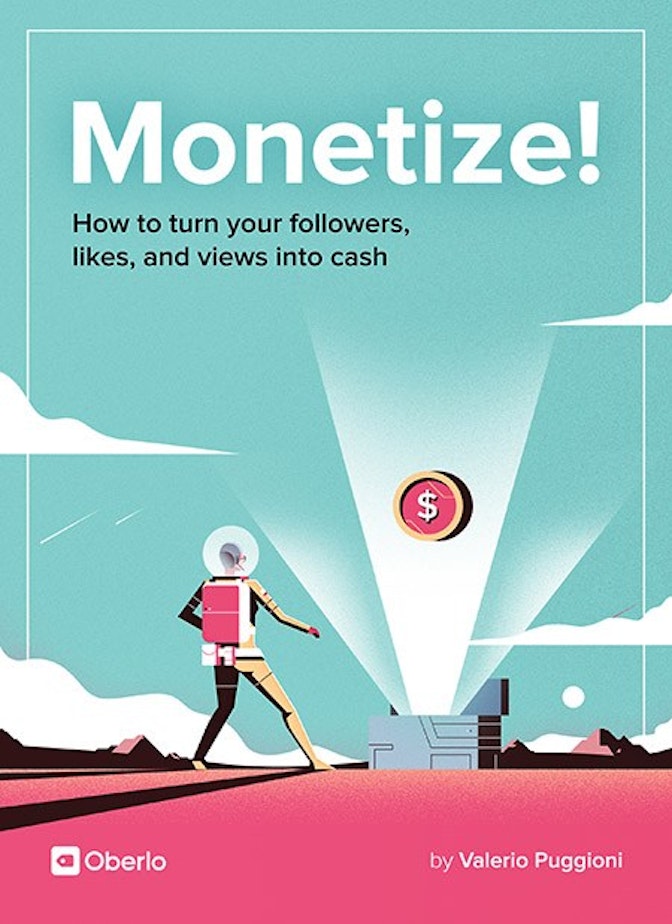In the first chapter, we went over several critical monetization concepts and principles, like focusing on what’s important, building a small but loyal tribe by providing something of value, and lastly, why it’s important to think long term, by building a brand that’s made to last.
Now let’s dig a little deeper into how to make money blogging.
Blogging has been around since the 1990s. But people didn’t intentionally go into blogging for money originally, at least not on a scale seen in these past few years.
You may have given it a go in the past. (Maybe you even had a blog on Xanga).
Or maybe you’ve already got an audience you want to monetize. (If so, awesome. You’ve got a head start).
But first, regardless of where you are in your monetization journey, it’s important to understand why starting a blog to make money is an excellent choice for your monetization efforts.



2.1 Why should you start monetizing with your blog?
There are many ways you can start monetizing your online audience.
- Some people launch a Youtube channel.
- Others open up a shop on Facebook through Shopify, and once they grow their brand, at some point they might consider setting up a website.
- And then there are those who simply open an Instagram account and start posting photos.
In other words, there is no right or wrong way to start monetizing.
So why start with blogging for money?
If it’s the smart money you’re after, here’s why starting a blog to make money is an ideal strategy:
You’ll never be at the mercy of another platform.
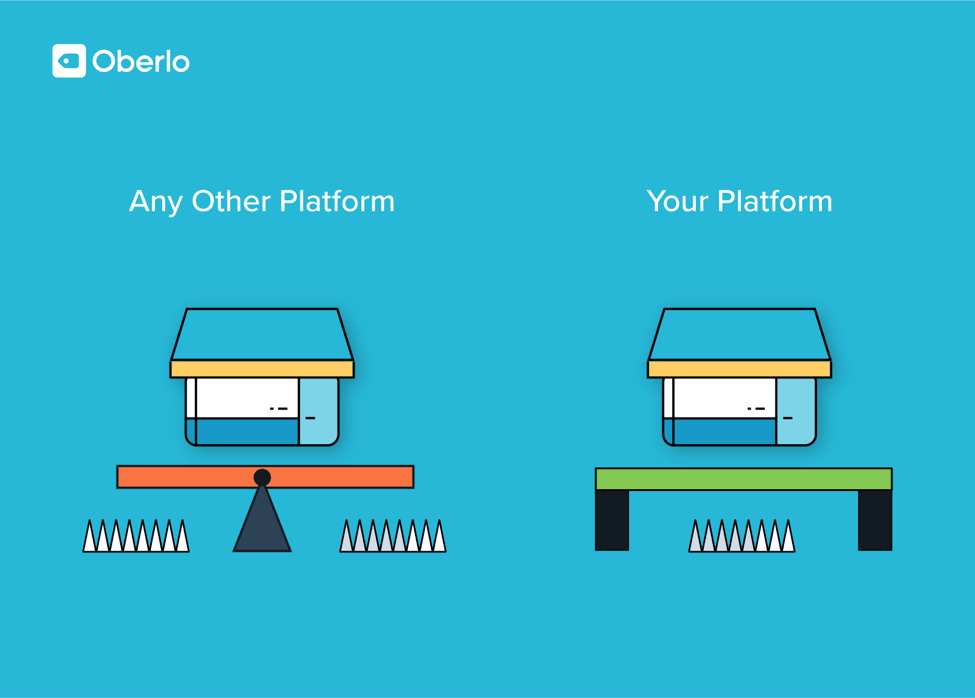
This is important to understand, because you want to have as much control over your business as possible.
So say, for some reason, Facebook decides to update its privacy policy. And somehow, this affects your account, and it’s suspended without notice. (It’s been known to happen).
Then, you say, “Oh, at least I’ve still got my Instagram account.”
Right?
Wrong.
Facebook also owns Instagram. So there’s a good chance your account is suspended across both platforms. (By the way, just in case you didn’t know, Google owns Youtube).
You get the picture.
But what about your blog?
Your blog gives you complete control.
That’s why you should treat it as your home base. (And then leverage your other “bases” like Facebook, Instagram, and Youtube, and encourage users on these platforms to visit your home base).
The diagram below shows outbound marketing as noise through a megaphone to reach as many people as possible. (It’s not targeted).
On the other side of the diagram sits a magnet, drawing people in. (Think of your blog. When people search for specific information on a search engine, a blog article of yours might appear, sending them inbound to your blog).
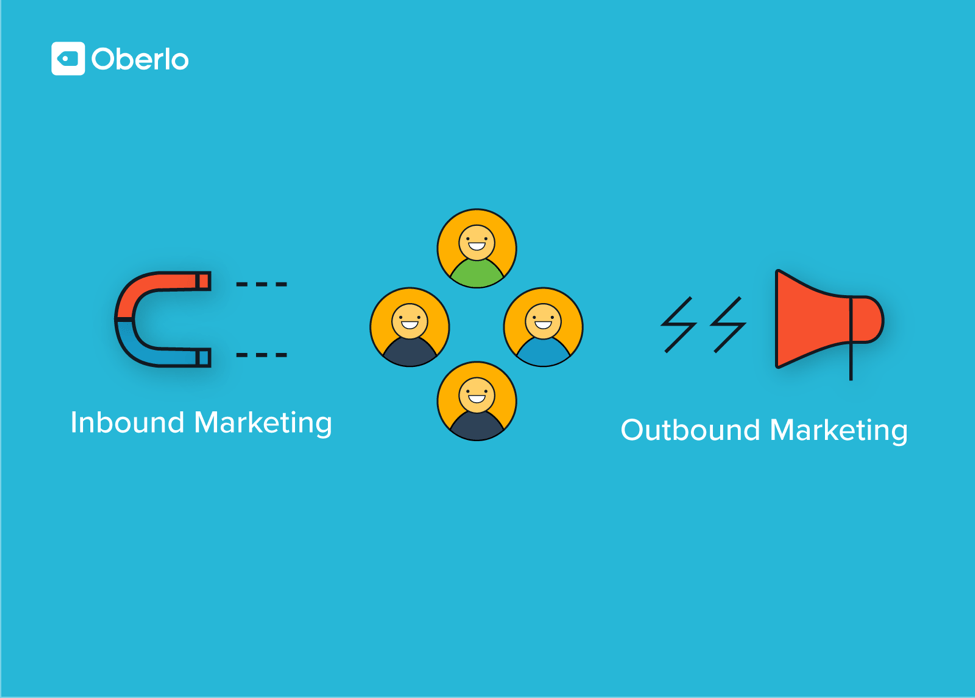
How blog monetization works
If you’ve been telling people you’ve been thinking about starting a blog to make money, there are people who will tell you not to quit your day job just yet.
And they may be right.
If you want to monetize blog readers, well, that can take time–a long time.
But remember what we discussed in the last chapter? About becoming what Kevin Kelly calls a micro-celebrity?
How you go about becoming this micro-celebrity is what we’re going to focus on here, because that’s the surefire way to creating a brand that lasts.
Becoming an authority: How to monetize your blog without ads
Before you can earn money from blogging, you have to position yourself as an authority.
That means you must become the go-to expert for your niche. As you can imagine, doing so opens up all kinds of doors, and this is what becoming a micro-celebrity is all about.
And you’re in luck, because blogging is the easiest way you can go about establishing yourself as an authority.
That’s because your targeted audience needs to consume your content and find value in the information you provide.
If that information improves their lives somehow, they’ll continue to come back to you because, as you communicate trust signals over time, they’ll perceive you more and more as a reliable and trusted source of knowledge or entertainment.
And you can capitalize on that in a major way.
Because after you build and are commanding an engaged and active audience, they’ll gladly pay for any offer you make (provided they perceive the tremendous value to be gained from your offers).
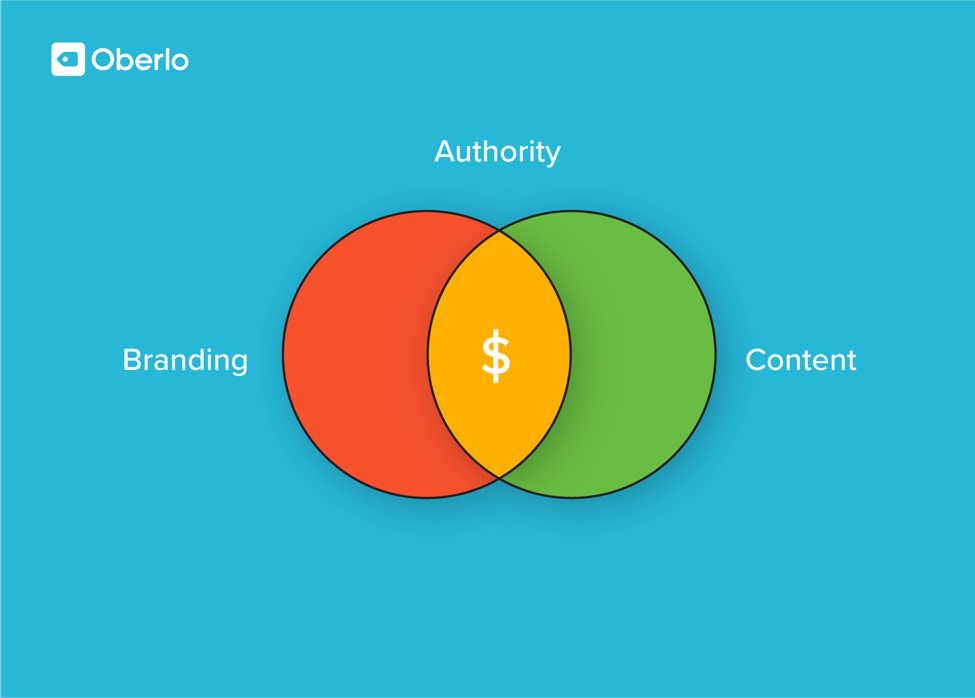
After all, as an authority, your audience trusts you.
And from there, you can easily begin to expand your reach to your social channels. (Like in your Facebook group, where you provide support to less experienced people who look to you for knowledge).
That way, you expose your readers to additional dimensions of your brand.
(Exposure through different channels helps cement your brand in your audience’s mind).
Now let’s get into the nitty-gritty details on the best blogging practices to position yourself as an authority in your niche and start to earn money from blogging.
2.2 How to earn money from blogging
Before we explore how to earn money from blogging, let’s first have a brief and frank discussion about the importance of transparency.
We already mentioned that once your readers start perceiving you as an authority, they begin to trust you.
For Spiderman, with great power comes great responsibility.
Believe it or not, this adage applies to you too.
As an authority, you can’t abuse the trust of your fan base.
There are many ways to do this, but the easiest way to fail your fans is to forget to be transparent with them.
See, not only do your fans trust you.
They expect a certain level of honesty from you.
That means:
- If you post an affiliate link to a camera, you should let them know you’re an affiliate with the camera company. (If they find out on their own, there’s a good chance they’ll feel cheated).
Just let them know like Booth Junkie does at the end of the example below.
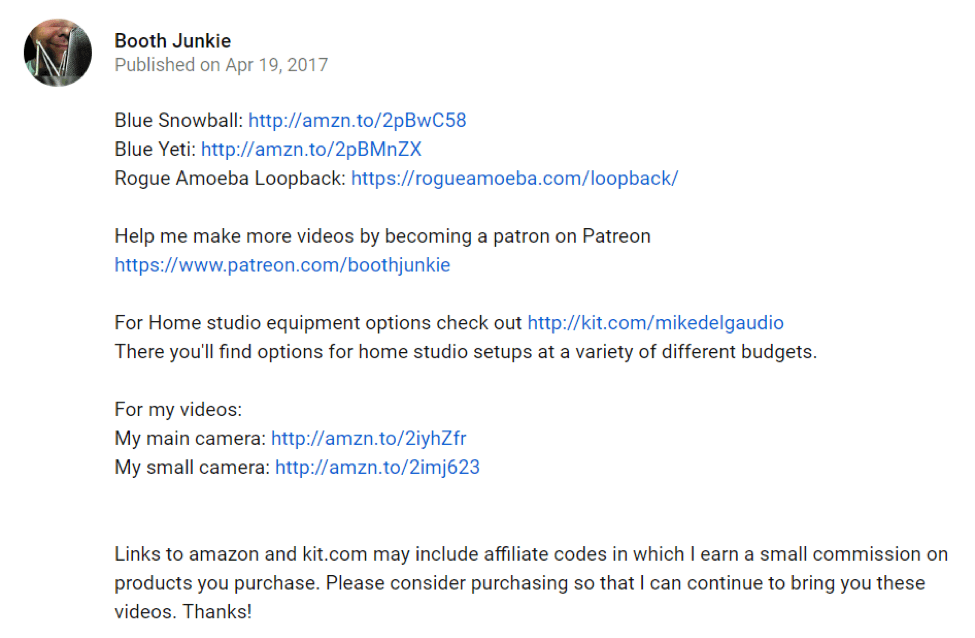
- If you review a backpack, give your readers full disclosure: You got the backpack for free as part of the review process. (They’ll appreciate the honesty, and come to love you even more).
You get the idea.
So don’t hide your intentions to monetize from your audience. As legendary adman David Ogilvy once said,
The consumer isn’t a moron. She is your wife.
How to decide what to write about: User intent
Let’s examine how to drive qualified traffic to your blog.
After all, not all traffic is created equal.
If 1 million visitors come to your blog and none convert, then your monetization efforts are futile.
That’s why the best traffic is from repeat visitors, because they’re the ones most likely to turn into loyal fans and purchase your offers.
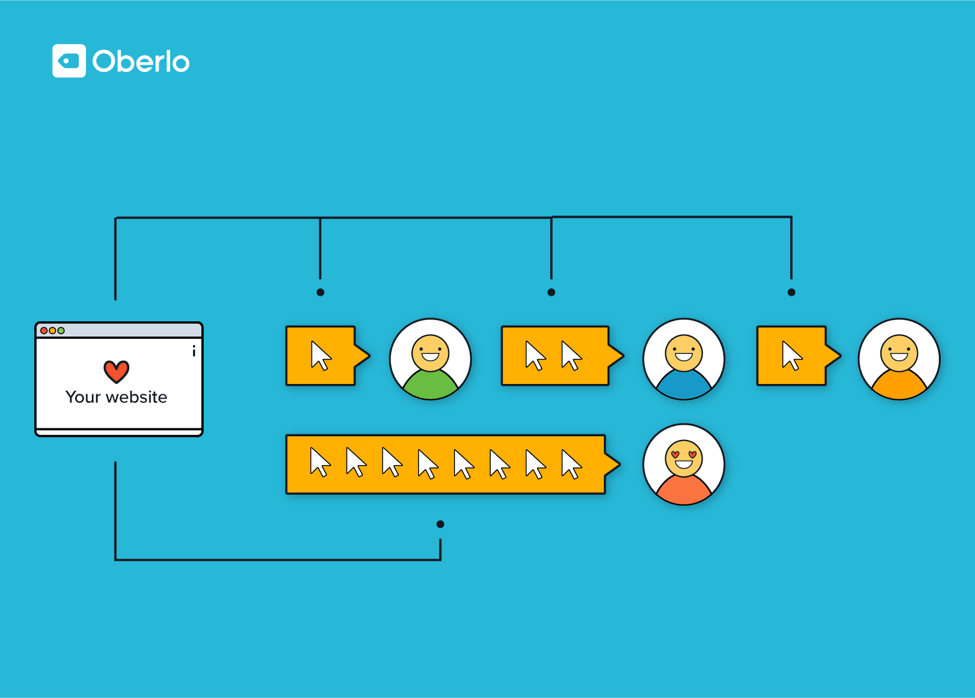
The trick is to figure out how to turn these repeat visitors into loyal fans.
That’s why we need to consider something called “user intent”.
Let’s look at a brief overview of the steps here.
Step 1. When people use search engines like Google, what kind of questions do they ask in your niche? Take some time to think about these questions and create a list with as many of the best questions you can think of.
Step 2. Do your research and search these questions yourself.
Step 3. Look at which websites pop up on Google for each question.
Step 4. Go through them and dig deeper into how these blogs answer the questions, which other questions they choose to answer, and so on.
Step 5. Map your best questions on a sales funnel. In other words, where do they fit in terms of your visitor’s journey?
A sales funnel can help you visualize how to organize your content.
Let’s look at how a sales funnel can be structured according to the classic “AIDA” sales formula.
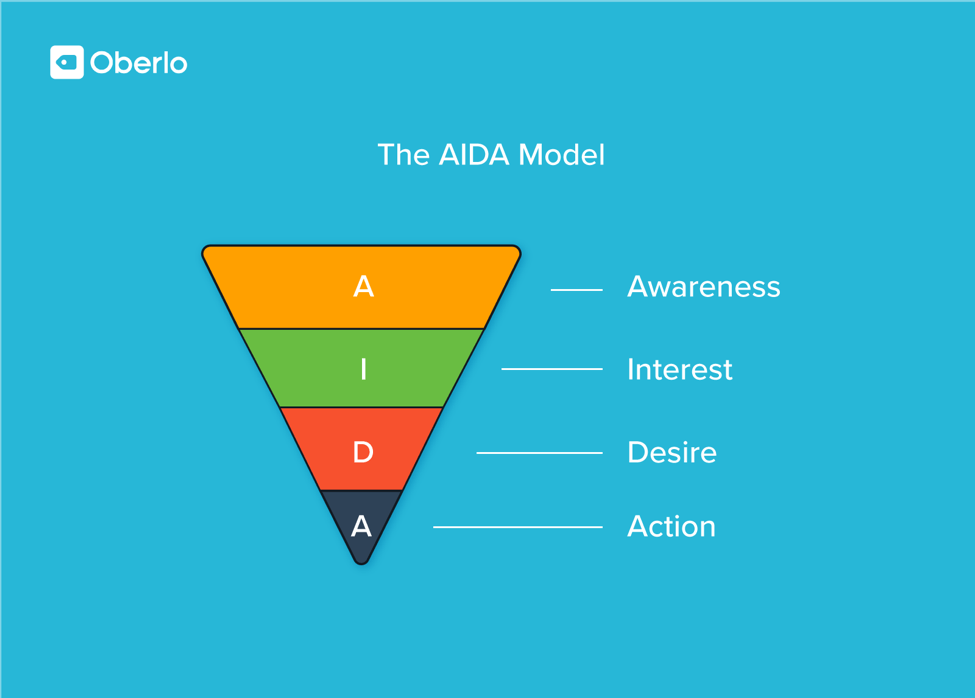
As the diagram above shows, AIDA stands for:
- Attention
- Interest
- Decision
- Action
Let’s look at an example of how this would work in practice:
Say you’re running a tourism agency in Rome, Italy.
So you think up the question, “How much money should I bring with me on a 2-week trip to Italy?”
Where does this question fit in your AIDA funnel?
That’s right. You would file this question under “Decision”.
What about the question, “Best tour guides in Rome”?
This is best classified under “Action”, even though it’s arguable the searcher might simply be researching tour guides.
(This would be the exception to the norm, which is why we would file this question under “Action”).
In other words, your visitors who are reading articles in the “Action” stage of your funnel are ready to take action and buy something related to what they’re reading.
That’s why, at the end of the article, you can present a relevant offer they’re highly likely to consider.
[highlight]This introductory article by Wordstream does a fantastic job of explaining user intent.[/highlight]
It’s all about building relationships
Over time, once your repeat visitors gain enough exposure and value from you that they come see you as an authority, you can begin to push various relevant products and services to them.
Sure, you can do this before as well. (It all depends on your approach).
But since we’re building a brand that’s made to last, let me show you the exact steps I take to organize the blog content when creating a blog to monetize blog readers.
Keep in mind, this is an overview, and we’ll go over the more technical aspects later because there’s a lot more to it than this (like choosing the right blogging platform for your goals, SEO, and link building, all of which are essential factors for monetizing your blog without ads).
Step 1. Start with a few pillar posts.
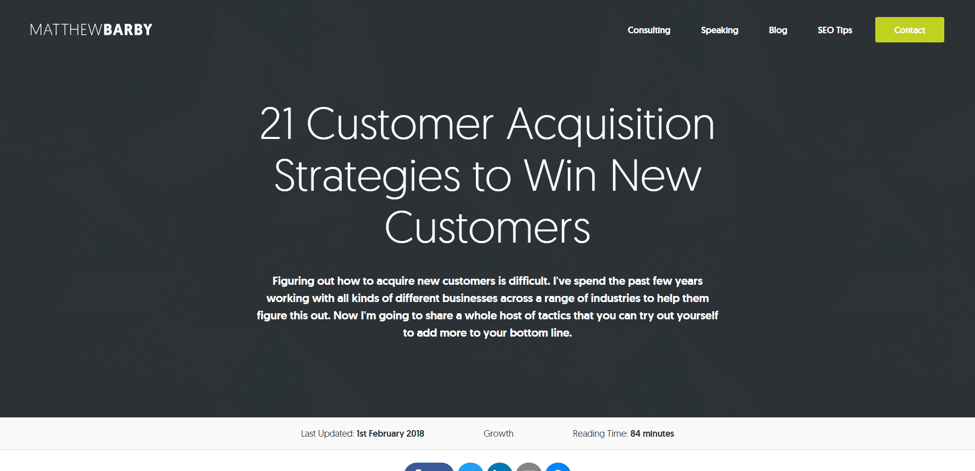
Pillar posts are comprehensive “evergreen” posts packed with a ton of value that drive traffic to your site over the long term.
That means they should be around 2,000 words, or even longer. (Note the example above, with a reading time of 84 minutes!).
So which topics in your chosen niche should you write your pillar posts for?
Think of the categories you would use in your blog.
If you’re trying to position yourself as an online fitness coach, then you might consider categories like fitness, nutrition, recipes, and success stories.

(See how I listed four examples here? I recommend starting out with three or four broad categories, which is a manageable figure, and then go from there).
Step 2. Create related, smaller posts around these large pillar posts.
Once you have these larger posts in place, you can begin to create smaller posts around them.
By making sure even these smaller posts are packed with value for your readers, they’ll begin to notice that your authority extends beyond just general knowledge.
In other words, these smaller posts will go a long way toward helping you cement your reputation further as an authority in your niche.
Step 3. Add internal and external links.
Once you have all your blog posts in place, it’s time to create some links.
Sure, you should already have built external links in your articles (links from your site to other high-authority websites).
But internal links (links within your site that link to other relate pages on your site) are important as well, so don’t neglect them, but don’t over do them.
Articles with too many links can appear overwhelming, and are hard to read.
The reasoning behind linking is that once you have all these links in place, search engines will have a better idea of what your site is about, and rank you accordingly.
Step 4. Add Call-to-action buttons.
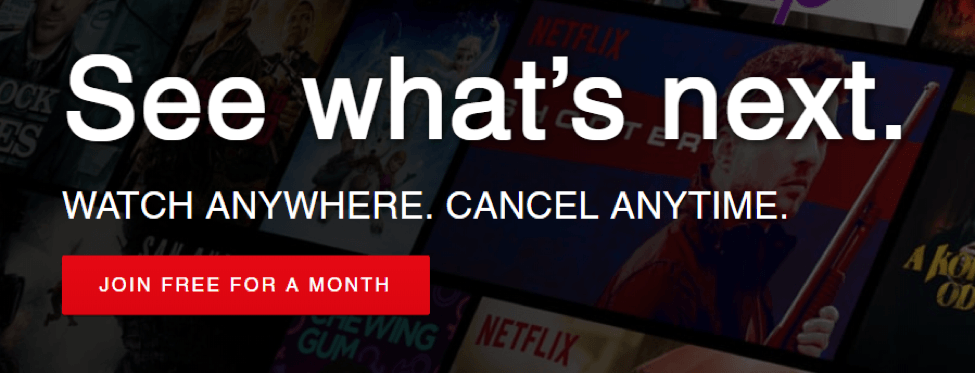
Call-to-action (CTA) buttons tell your reader what action to take next.
For instance, if you write an article about how to charge $200 per logo instead of $20, it makes sense to add a CTA button at the end.
The text before it could read something like, “Want to learn how to charge $400 instead of $200, and do so consistently?”
Then the button: “Yes, show me how.”
And that button could lead to a sales page.
If the sales page does its job, voilà!
You’ve set up your first working monetization pipeline.
So how much money do bloggers make?
At this point, you may be wondering how much money do bloggers make.
And that’s fine.
But at this stage, you should already know the answer to this question:
It depends.
Sure, it’s fun to ask yourself, “Just how much money do bloggers make?”
But a better question would be, “How much can you make?”
And are you willing to work for it?
After all, if you want to monetize, blogging takes hard work.
So does establishing yourself as an authority, someone your loyal fans will look up to as a reliable and trustworthy source of information.
Maybe then, the best question to ask isn’t, “How much can I make?” but, “How much value can I provide to my audience, my loyal and loving fans? What can I offer that’ll make them love me so much, they’ll continue to recommend my products, new and old, for years to come?”
Just imagine:
As an authority, think about how much easier it will be to
- Sell your audience a course (or many related mini-courses packaged in a bundle!)
- Sell your coaching services
- Sell info-products
The possibilities are endless.
As for an answer to the question, How much do bloggers make?
It depends, and it depends entirely on you.
What’s it all for? The ultimate goal of building a healthy email list
Here’s the last reason you should consider blogging for money before anything else:
You have complete control over your email list.
It’s your list of leads, converts, and fans.
And this list is your prized possession for three reasons:
- Your inbox is your most personal space. You check it multiple times a day. I bet you’ve had the same email address for years. (It’s easier to switch phone numbers, isn’t it?). That means you can email these addresses and start communicating with their owners. Even if you expect none of them to reply, some of them will (and that’s a perfect opportunity to initiate a dialogue).
- Your visitors gave you their email address willingly. This means they gave you permission to email them. This means they expect you to communicate with them.
- Most importantly, it costs you nothing to market to this group. Sure, you’re mainly sending them emails packed with value that align with their expectations.
But while you’re doing that, you’re further cementing your authority and gaining brand exposure at zero cost.
And once in a while, you can plug something you want to sell as well (like a new course that’s on the way; you can even encourage your mailing list to subscribe to the waiting list).
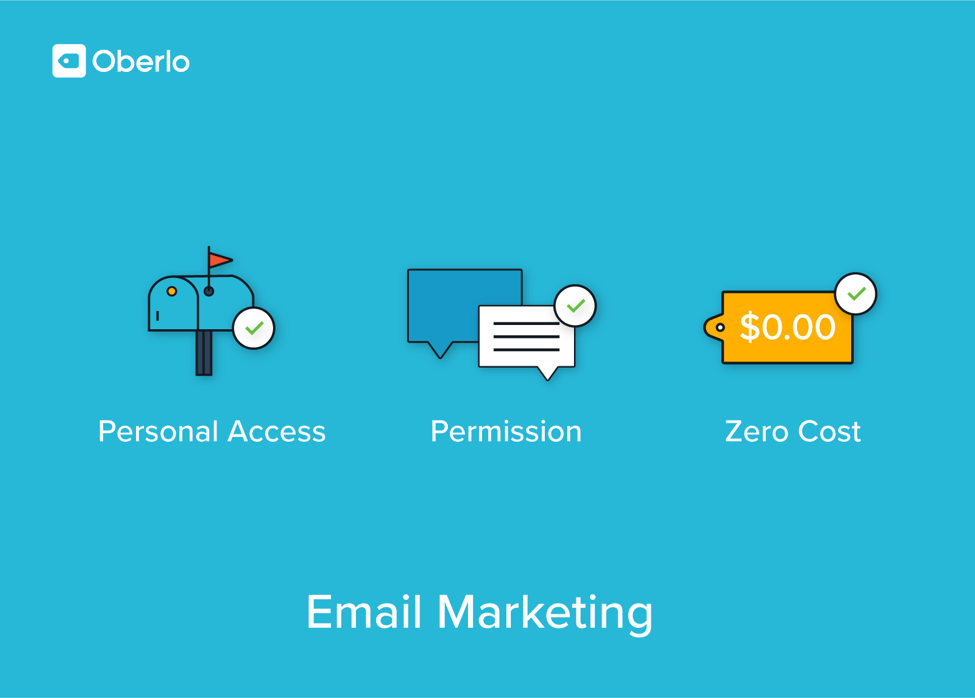
Now can you see why so many marketers and businesses prioritize building their email list?
So there’s no question that blogging clearly can be profitable.
But if you’re someone who’s looking for a few quick and easy ways to monetize, blogging may not present the best get-rich-quick opportunities you want.
However, if you’re looking to build a brand long term that your fans will love, blogging for money is the way to go. It’s is an excellent long-term option that can be extremely rewarding, one that can lead to a consistent and reliable source of income.
Don’t have a blog? Let’s get you started with a few blog ideas that make money.
Starting a blog to make money isn’t as tricky as it once used to be.
In this section, we’re going to go over several examples of blog ideas that make money.
Courses
Courses are all the buzz these days.
You can find a course on any topic, and platforms to host your courses on are multiplying rapidly, making it easy for anyone to create a course and start making money right away.
Even with a small fan base, as an authority you can easily start selling mini-courses for $50 per student.
After completing your courses, if your students believe they’ve gained greater value than what’s listed on your price tag, then many of them will eagerly continue to promote your courses for you (and you can even offer promotional items to encourage your fans to refer your courses to other interested parties).
Let’s look at a course example with travel blog monetization.
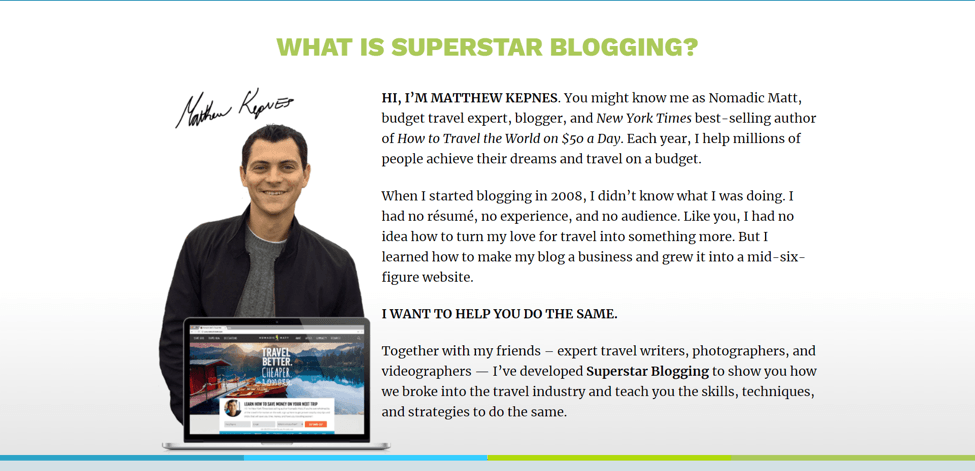
Matthew Kepnes, also known as Nomadic Matt, teaches millions of people how to achieve financial independence through travel.
Go check out his courses to get a better idea of how he structures them.

Consulting services
Providing consulting services can be a profitable venture from the get-go, especially if you’re already knowledgeable in a particular subject area.
Even if you’ve only got a couple years of work experience, don’t dismiss it just yet.
Instead, think about what you’ve learned, and take some time to consider what you’re really good at. Then think about how you would start to position yourself as an authority based on what you know.

Just look at the example above, from life coach Amber Rosenberg.
If you’re good with people, and you’re a positive individual, you may be a perfect consultant or coach in the making.
To read more about how to start a consulting business, check out this article from Entrepreneur.
Brand sponsorships
If you’re already seeing a lot of traffic on your site, you can try connecting with bigger brands that might want to sponsor you in order to gain access to your audience.
Just look at this gorgeous and clever food blog monetization example by Damn Delicious.
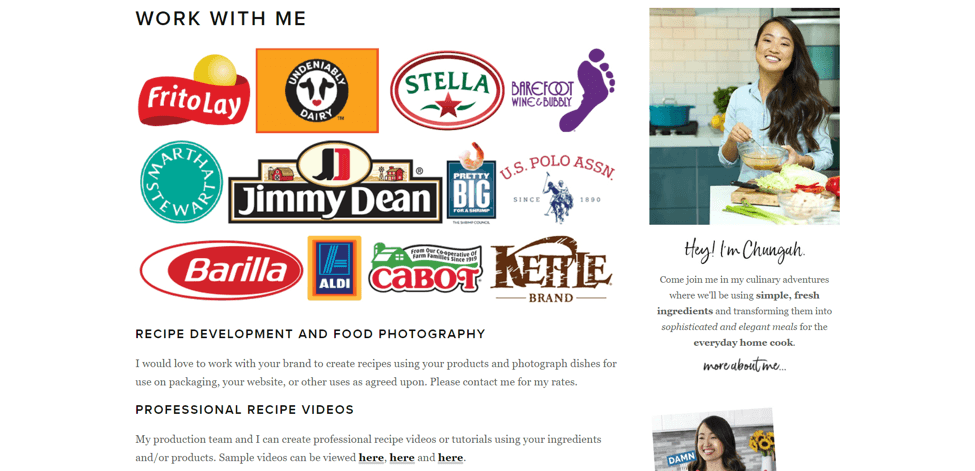
Ecommerce
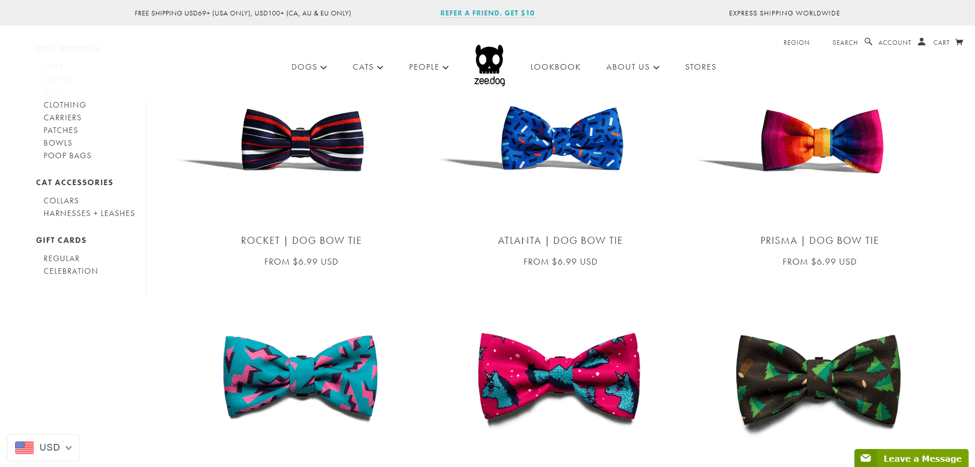
Ecommerce is a popular monetization option these days, especially if you have a background in marketing and branding.
Like every approach, ecommerce comes with its own advantages and challenges.
Plenty of entrepreneurs have achieved considerable success with this model.
(Do be cautious of sellers pushing courses in this space though. There are many, and few are worth it. Save yourself some time and money by starting with our free guides here).
[highlight]Interested in exploring even more blog ideas that make money? Here are 50 examples of successful ecommerce stores running on the Shopify platform.[/highlight]
A niche blogging example: How to make money travel blogging
Travel blogging: A dream for many, achieved by few.
Can you really become a digital nomad and make a ton of money traveling the world?
Absolutely.
If you know how to make money travel blogging, you can make anywhere between a few hundred a month to a six-figure income–but it’s not easy.
In fact, if you love to travel, but you’re not that passionate to want to cover every single aspect of it, perhaps it’s best to consider another niche.
Travel blogging is harder to monetize than, say, a blog about web design. (So many web designers are ready to start courses filled with promises of enhancing their skill set to save them an endless amount of time and money).
Keep in mind, the one big plus about being a travel blogger is that your expenses will vary by country. And if you’re thinking about hitting up developing countries, then you’re going to be keeping your expenses relatively low and affordable as well.
Let’s look at how Caz and Craig Makepeace, the founders of y Travel Blog, grew their blog.
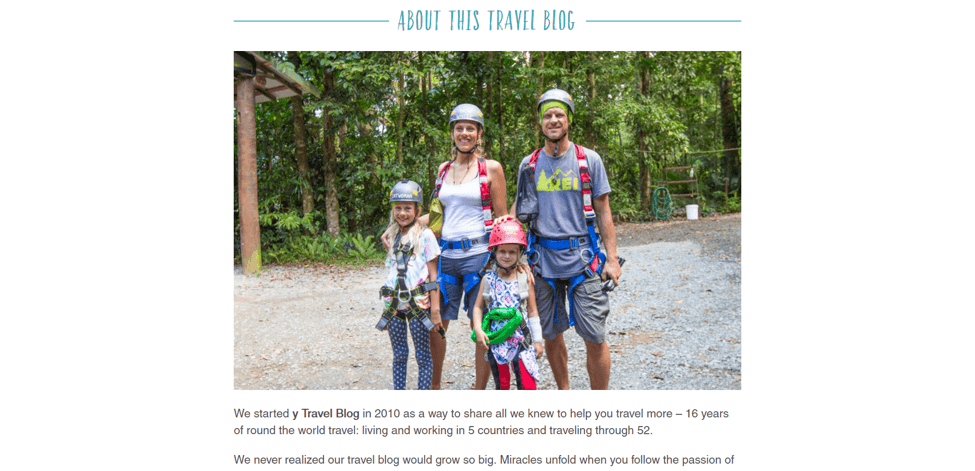
Caz and Craig have traveled for around 20 years.
They started their y Travel Blog nearly 10 years ago.
They never imagined it would grow to its current size. (To give you an idea, they reach roughly 350,000 readers every month).
They’ve partnered with the likes of SkyScanner, and they’ve even been featured as travel blogging experts by Lonely Planet, CNN, and even Business Insider.
Now they teach bloggers like you how to make money travel blogging. (Funny, right?)
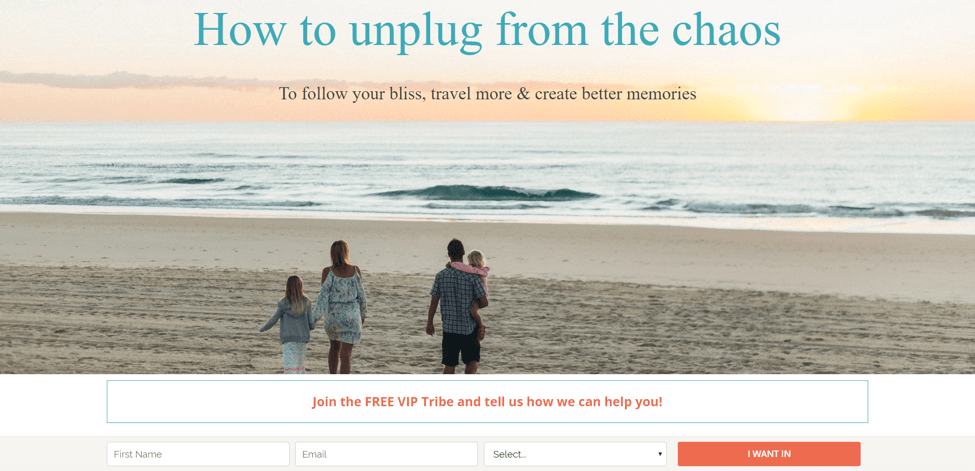
So were they experts in travel or blogging when they were first starting out?
The answer is a resounding no.
Their secret ingredient?
An undying passion for travel.
If this sounds like you, and you’re considering this niche, here’s a few ways you can make money travel blogging.
Publish sponsored posts
If you have a sizeable readership, you can approach companies in the traveling industry and ask if they’d be interested in promoting their products or services through your blog.
To keep it professional, begin by creating a list of companies you want to work with. You can start collecting ideas by looking at yourself first.
You’re a traveler after all, right?
And don’t think only of businesses that are related directly to travel. (For instance, you could also consider featuring your favorite travel pillow. Or an awesome hotel you remember staying at).
The trick is to believe in the product.
What you don’t want to do is annoy your readers with sponsored post after sponsored post. That’s got to be the fastest way to alienate even your most loyal readers.
But if you recommend something you love, they just might buy it from you.
If possible, provide some context for these posts though. That way, you can leverage even sponsored posts, and use them to boost trust and engagement.
Write content for companies like Kayak
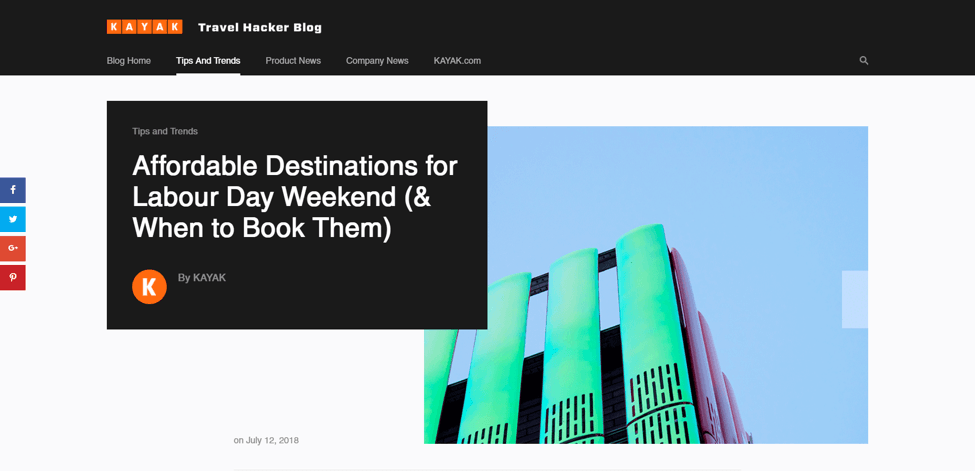
Companies like Kayak and Skyscanner don’t have offices in every city around the world. (Most companies don’t).
But what makes these companies excellent targets for content prospecting is that they love content that promotes local tourism spots.
And because travel blog readers make frequent purchases, these companies are willing to pay top dollar for quality content.
(Would you be reading an article entitled, “Taipei’s annual flower exhibition and 11 other fun things to do in the city” if you weren’t planning to take a trip to Taiwan?)
Reach out to local tourism boards
Reaching out to the local tourism board before you travel is worth a shot, especially if your destination country is someplace like Laos (a developing country whose economy is heavily reliant on tourism).
If you can show evidence you’re receiving a ton of consistent blog traffic from intent travelers, this could turn out to be a profitable income stream.
Let’s take the Laos example:

For such destinations, travelers frequently express safety concerns.
Blog posts dispelling the myths regarding the dangers posed there, as well as tips on how to stay safe play well with this audience, and go a long way toward building trust
Offer coaching services to travel agencies
If you can become a travel authority, and your blog boasts a highly engaged readership, travel agencies and tourism businesses will take notice.
At this point, you’ve got a lot to offer, because you can tell what’s working in the industry and what’s not.
You may even have written about the warning signs of a bad travel agency, or how travelers can travel in style at half the cost of what travel agencies have to offer.
Whatever the case, your job is to make sure they recognize your value–or it’s their loss.
Set up your own niche tour guide business
If you’ve decided to settle somewhere for a while, you’re going to get to know the local spots.
But writing isn’t the only thing you’re going to do here.
In fact, part of the reason you’re writing this series of articles here is to promote the destination–but with a twist:
To drive your readers to not only consider your location as their next tourist destination, but to encourage them to sign up for your “special” tour packages, which are reserved exclusively for your readers.
This way, not only do they get to enjoy a truly unique experience, they get their favorite travel blogger to give them the official tour!
[highlight]To find out more about how to make money travel blogging, check out Caz and Craig’s in-depth guide.[/highlight]
2.3 How to transform your blog visitors into loyal fans
We’ve already covered the importance of providing valuable content in Chapter 1.
It’s what our definition of monetization is all about, after all.
Remember?
Making money by providing something of value.
But no matter how great the value, if your content is difficult to absorb, no one will want to read it in the first place.
So let’s go over some ways on how to write engaging content.
How to write engaging content
This is the meaty part of the chapter.
This is where you get to show off your writing chops. Here I’ll go over some key principles on how to increase engagement and make sure your readers are glued to your articles until the very end.
We’ll also briefly cover the technical aspects of blogging, and why they are critical for your monetization efforts.
Finding your voice
Finding your voice could take years.
You don’t have years. Or months. Or even weeks.
You want to start now.
So here’s the best writing advice I can give you to improve super fast:
Write like you talk.
Seriously.
Once you’re done writing, read all your work out loud, so that you get a better feel for how it sounds.
You know that voice in your head that’s talking while you’re reading this?
Turns out, that’s a real voice. (Small muscular movements in the larynx accompany your inner voice. How cool is that?)
Readability
Readability is important because it’s about how easy it is for your readers to understand your message.
The Flesch–Kincaid readability tests are the standard scoring system for gauging a text’s readability level.
Keeping in mind that the “average” American reads at a 7th or 8th grade level, you should always try to communicate your message in as simple a manner as possible.
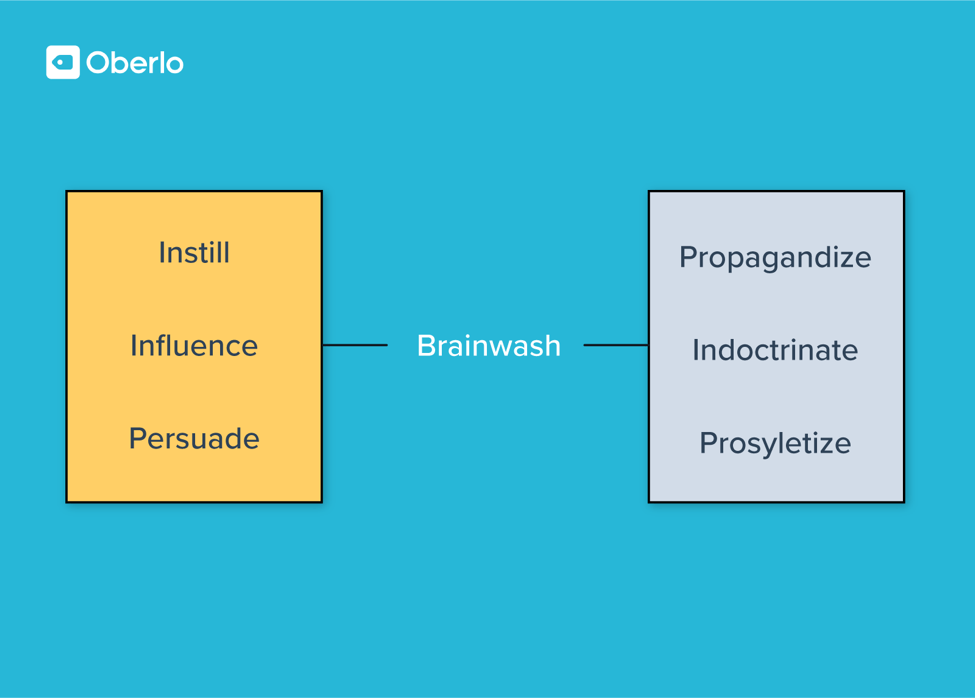
After all, if a message is too difficult to read, what are the chances you’ll try to figure out what it’s trying to tell you?
If you’re blogging on WordPress…
Yoast SEO Plugin already comes equipped with a Flesch–Kincaid readability feature. You can easily keep track of your readability level for every post.
Also be sure to write in short paragraphs of one to four sentences.
Long paragraphs are hard to digest on the web, especially when they’re formatted in a single column.
That means you should vary the number of lines per paragraph.
Font choice and legibility
Font choice is an important consideration for two reasons:
- It says a lot about your brand’s personality.
- It has to be easy to read.
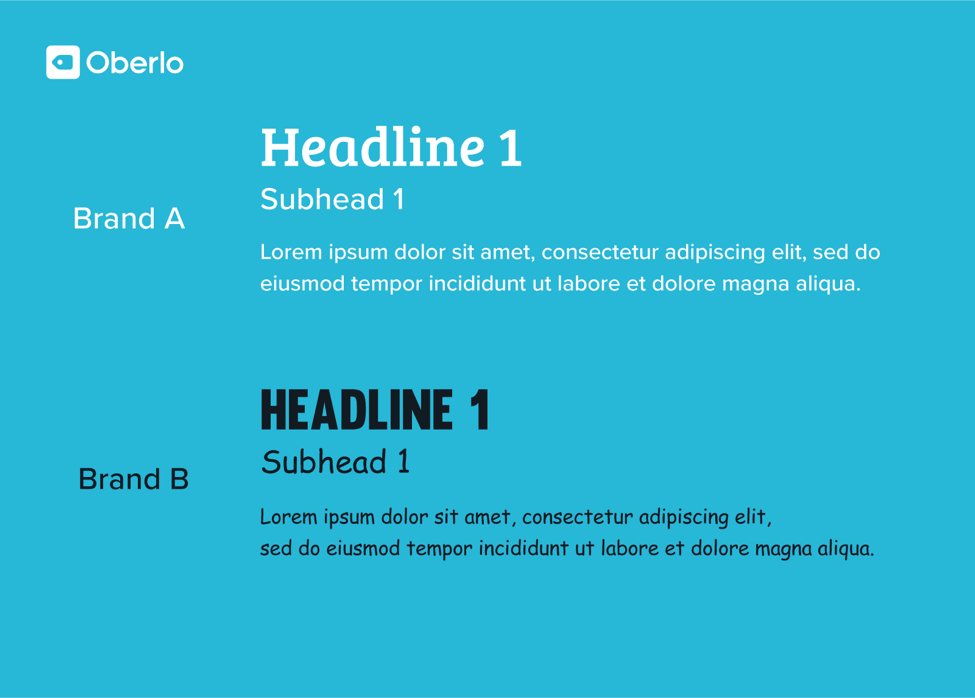
Keep in mind, it’s harder to read text on-screen for prolonged periods than it is to read print.
My recommendation is that you go with a large-enough sans serif font. (Serif fonts are easier to read online, as shown in the example below).
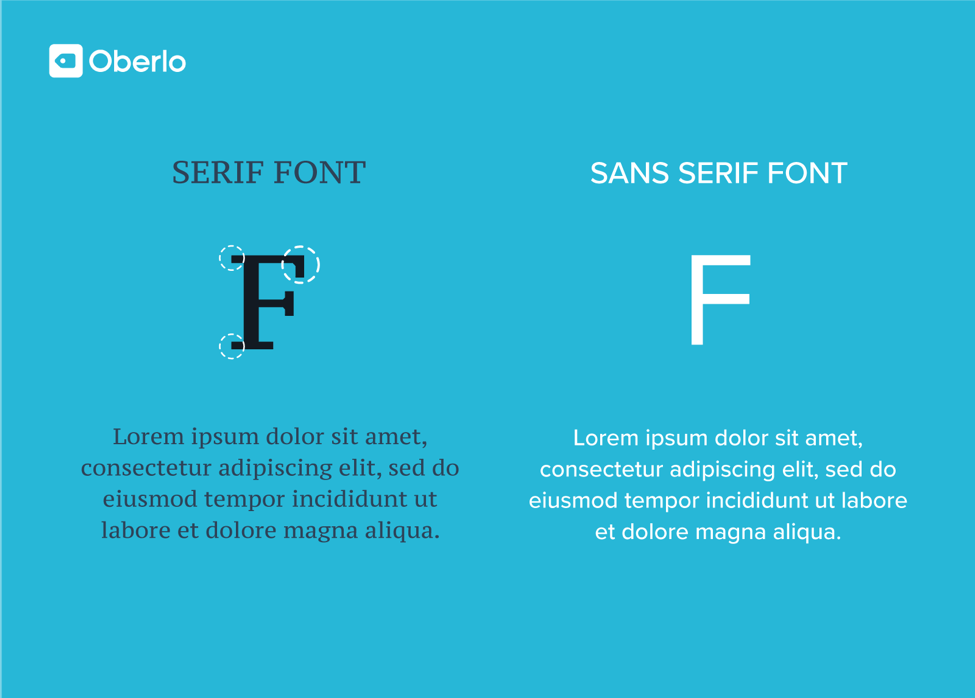
SEO
Search engine optimization (SEO) is when you intentionally try to influence where you appear on a search engine’s ranking.
Your understanding of SEO will be one of the main drivers behind your blog’s long-term success, because you’ll get to climb past your competitors who ignore SEO.
SEO falls under two main categories:
- Keyword research
- Link building (acquiring links from other sites)
Because SEO is such a huge (and ever-changing) topic, unfortunately it falls outside the scope of this book.
To get started on keyword research, Moz’s comprehensive guide for beginners remains the go-to resource in 2018.
It’s not over when you click “Publish”
Just because you click “Publish” once you’re done writing doesn’t mean people will land on your page automatically and read your article.
It’s the most common mistake novice bloggers make.
Writing the article isn’t even half the battle. It’s more like 20%.
The real work comes with promoting it. And there’s just so many ways to promote your writing. It isn’t only about backlinks (which we’ll get to in a second).
It’s also about active engagement.
That means you have to be a part of an active network of bloggers in your particular niche.
Encourage action among yourselves. Read other blogs in your network and leave thoughtful comments.
Too often, people leave haphazard comments and expect a comment back.
Don’t.
If you leave enough thoughtful comments, over time, the other bloggers will do so as well.
Don’t forget to ask for feedback too, especially if you’ve already established a relationship.
Long term, it will pay off 1000x and save you a ton in marketing dollars.
Backlinks are a goldmine for blog monetization
Backlinks are links from sites that link back to you.
The greater the number of authoritative sites linking back to you, the higher your website will appear when someone searches for a particular keyword related to your niche.
But not all backlinks are created equal.
In fact, Google scores high-authority sites higher than their low-authority counterparts, meaning if sites like Amazon and Yahoo link back to your blog, your authority would be much higher than if yourmomsblog.com and yoursistersblog.com gave you backlinks.
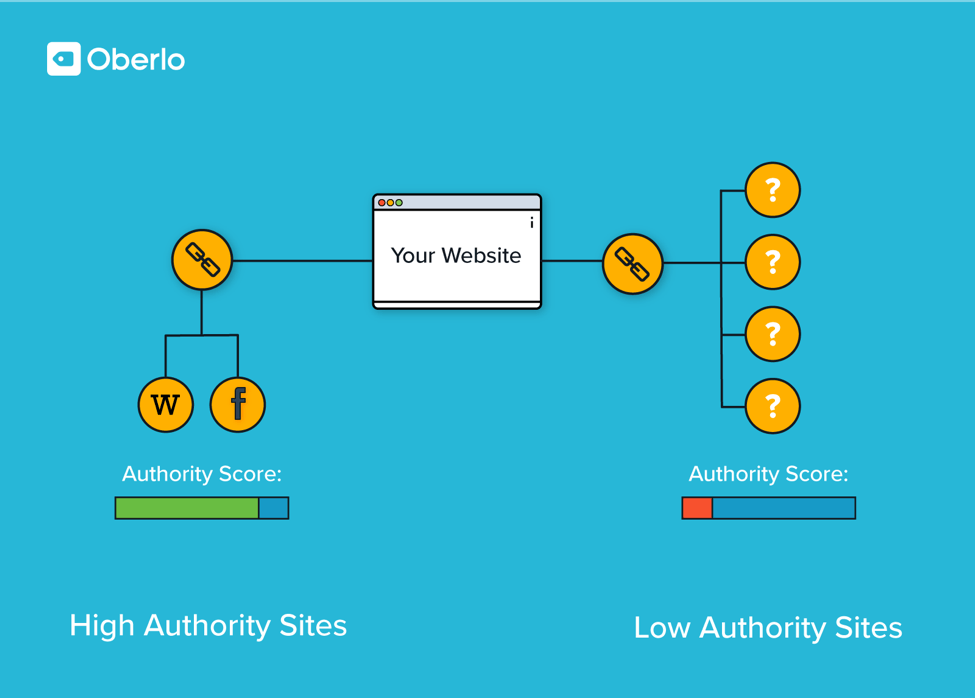
[highlight]If you want a fast tool that tells you instantly if a site you want a backlink from has a low or high authority score, Moz’s free MozBar SEO Plugin does just that in the form of a toolbar.[/highlight]
Here are my four favorite ways to acquire backlinks:
1. Search Google for resource pages in your niche.
(Example: “your niche + resources”)
Once you find a broken link using a Chrome extension like Check My Links, you can contact the webmaster to let them know what you found.
This places you in an ideal situation to ask if your related post can be used as the replacement link.
If they find it helpful, there’s a chance they’ll give you the backlink.
2. Find blogger reviewers for your offers.
(Example: “your niche + review”)
Once you find reviews of similar offers (like for a course or a product), you can reach out to these reviewers and present your offer in exchange for a review.
If they’re savvy (many of them are), they might even be interested in pursuing a mutually beneficial agreement, where they even help you push your offers on their site.
3. Write guest posts.
If you already read other blogs in your niche, then you’re in luck. If you comment on them and engage with the authors, even better.
This means you’re in an ideal position to reach out and ask if they’d be interested in exchanging guest posts.
(Meaning: You write a blog post to be published on their site, and vice versa).
This way, you can exchange links.
Google loves links from relevant sites, and ranks them higher.
4. Write testimonials.
In your journey to start making money blogging, you’ll undoubtedly end up investing in a tool or two.
They present easy opportunities for you to write an in-depth review for potential customers of these businesses. (These businesses tend to be high-authority sites).
But instead of posting your review and forgetting about it, contact the business and let them know about your review. (In your message, be sure to mention your blog address under your name).
That way, not only will they appreciate the review. If they feature it, there’s a good chance they’ll link back to your site.
Ways to keep your readers engaged
Have you heard of dwell time?
According to SEO experts in the industry, there’s a really good chance Google considers dwell time a ranking factor.
Dwell time is the duration of time your reader spends on a page after clicking on your link from the search engine results, and then going back to the search results to click on another link.
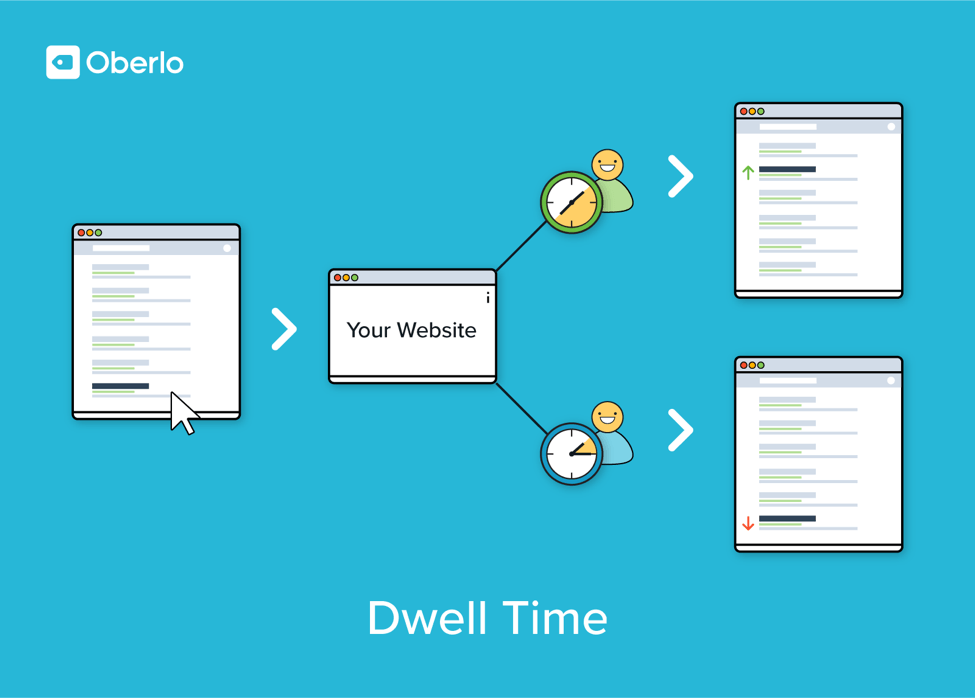
This is where engagement comes into play:
The longer you can keep your reader engaged, the higher your site will appear organically (free) in the search engine rankings.
So how do you keep your readers engaged?
Videos

Videos are becoming increasingly popular, and they’re becoming a staple in smart blogs.
Smart bloggers are using video to keep their readers on-site for longer periods.
This provides three main benefits:
- It takes time to watch a video, so it’s an easy way to keep your readers on your page.
- Videos can help add dimensionality to your brand, especially if you show your face and engage with your audience through your videos.
- Your reader might click through to your Youtube channel and check out other videos you’ve posted.
Stats, facts, and graphs
People like numbers, stats, and facts.
That’s because they lend a certain authority to your data.
But guess what people love even more than numbers, stats, and facts?
Graphs.
People love graphs. And they tend to trust them implicitly.
With a statistic, some readers may be skeptical.
But package the same data in a graph, and there’s a good chance that skepticism will vanish.
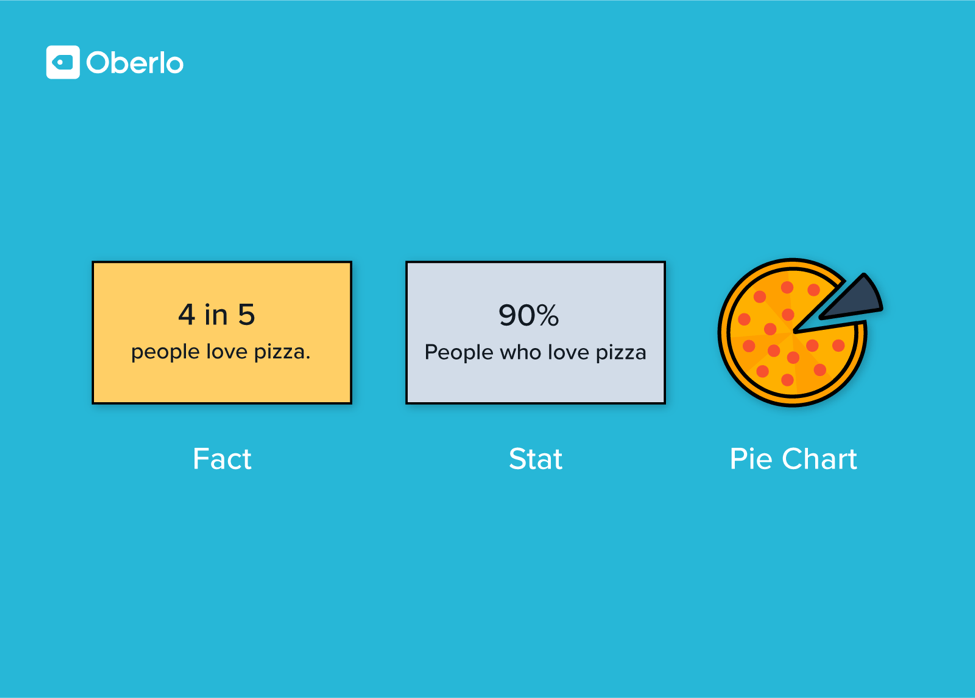
Graphs also lend a visual dimension of authority, and they function as a context-enhancing pattern interruptor (interrupting blocks of text).
Quotes
Quotes from other authority figures rub off on your own authority.
If you make a point about something, and you add the quote of someone reputable in your niche to support your point, then you’re going to appear that much more believable instantly.
If you use blockquotes and center the quotes, you can even use them as pattern interrupters and snap your readers back to attention.
If you can demonstrate that you have a personal relationship with the authority you’re quoting (which means you can give your readers a direct quote), even better (like if you’re writing an article on how to be funny, and you’ve got a direct quote from Jim Carrey, saying, “That’s right. One thing I would add is…” Magic).
This shows you have a relationship with serious authorities in your space, which further cements you as a genuine authority who can be relied upon.
Stories
Humans have been telling stories since the dawn of time.
Storytelling is hardwired into us. We love telling stories every day, and we love hearing them too. We watch movies, read books and articles, and scour social media every day for interesting stories to absorb.
Starting your article with a story can help draw your reader in, especially if it’s relatable and compelling.
The engine driving every story is conflict, so try starting your story with a problem your reader might have, and guide them to the conclusion.
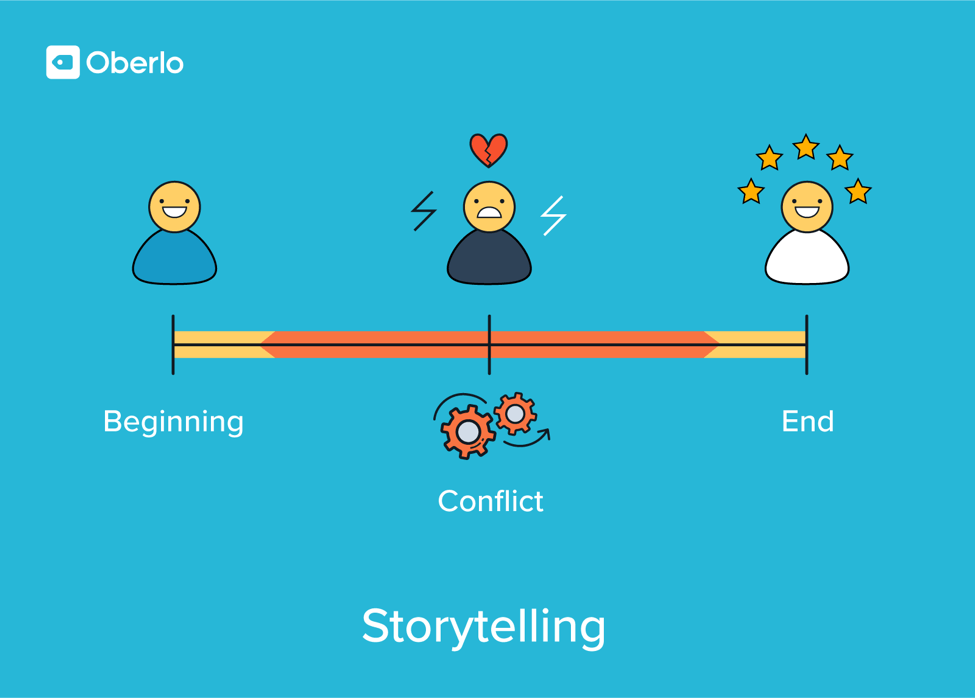
Let’s talk lead magnets
Remember how we talked about the importance of building your email list earlier?
To get your visitors to give up their email address, you can’t simply ask them to subscribe to your blog.
The offer just isn’t enticing enough.
That’s why you need to hook them with a more compelling offer. Something that’ll provide them with enough of an oomph to give you their email address, like Rich Page does with his free toolkit pictured below.
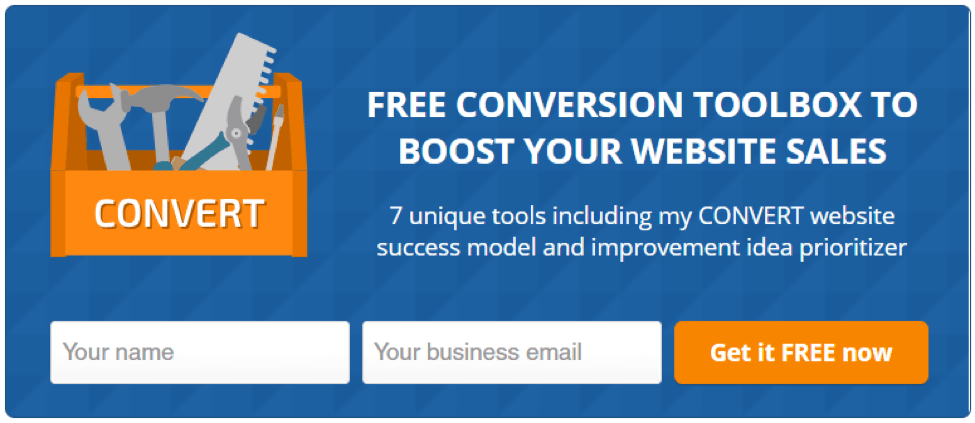
There are many lead magnet ideas out there. (Just look at this monster list of 69 lead magnet ideas).
Having said that, here’s a list of popular lead magnet types, and why they’re a good option for your blog.
Ebooks
Ebooks are one of the most popular types of lead magnets, and there’s a reason for that.
They’re fairly easy to create, especially if you’ve got a ton of content (or investment capital).
They’re also compact (if they’re well designed), and you can read them on your phone or tablet (super convenient).
Just the idea of getting a free book makes for a compelling offer, after all.
Repurpose: If you’ve got a lot of content, you can always collate a few related articles into an ebook, write an introduction and conclusion, polish up the rest, attach a pitch or a CTA to a sales page at the end of the book, and you’re good to go.
Investment capital: If you have money to invest, consider hiring a good freelance writer to write your ebook for you.
There are many out there.
Most of them aren’t very good, so do your due diligence and ask for samples.
Good writers cost money, so don’t scoff at their rates, and prepare to fork out at least a few hundred dollars for a decent ebook.
But do consider whether and how you can make that money back, and whether it will be worth the investment.
Downloadable PDF version of comprehensive (2,000+ words) article
This one’s a no-brainer.
Many people just don’t have the time or the attention span to read a comprehensive article in one sitting.
Some people prefer to save it as a PDF file and read it on their phones while they travel during the day or when they’re taking a break at work.
So just do your readers a favor and offer every lengthy post as a downloadable PDF, and you’ll be collecting more emails effortlessly in no time.
[highlight]Transform your blog article into a PDF with ease. Check out Print Friendly for quick and easy ways to turn your articles into PDFs. (They even have a Chrome extension, as well as a button you can install directly on your blog). [/highlight]
Infographics
Infographics are comprehensive graphs packed with information.
But they’re also organized visually in such a way that they encourage sharing.
Creating infographics isn’t easy though. They take a lot of hard work, especially if you’re not visually inclined.
Not to mention all the research and how you choose to organize all your data.
Here’s an example of just how helpful an infographic can be in visualizing a workflow process:
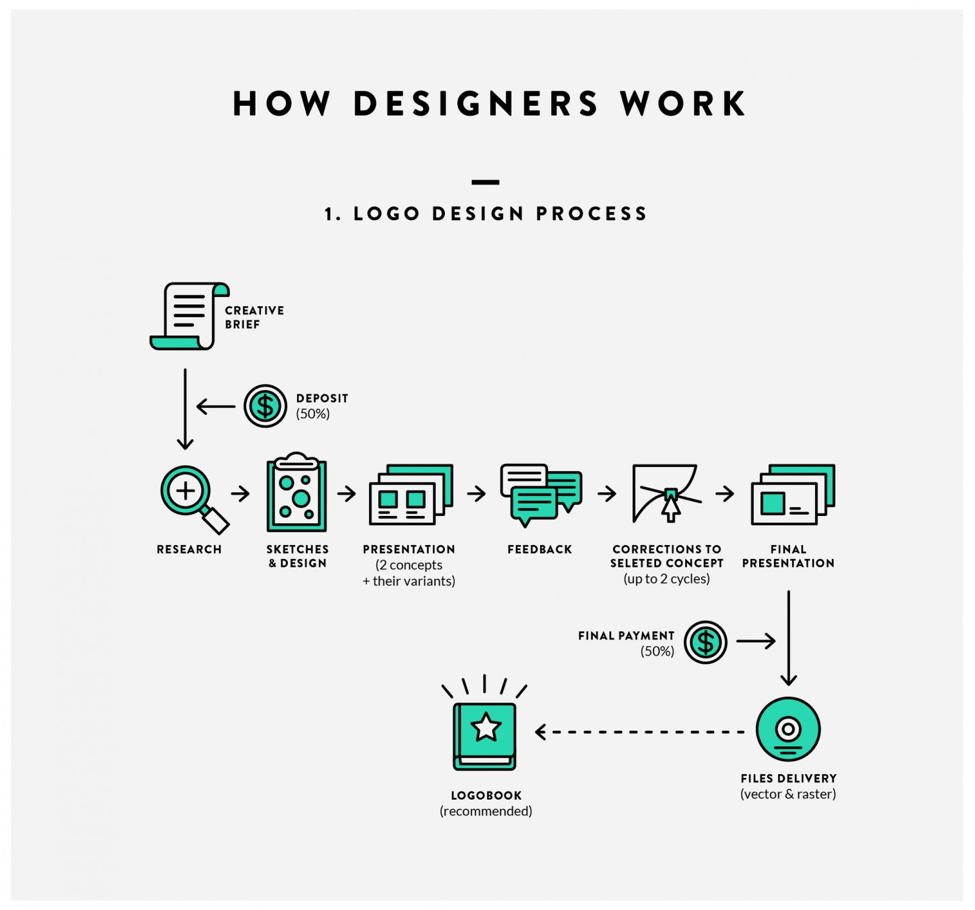
Infographics are also an easy way to acquire backlinks, and present significant opportunities for your content to go viral. Here’s a few other ways they can help your business.
Check out this example of an on-page infographic, which was too awesome not to share.
Members Only section
If you have enough valuable content and you’re seeing a lot of repeat traffic, it’s time to consider walling off a part of your site to paying members.
You don’t have to charge a significant sum.
It can even be just a dollar to start with.
If you pull this off successfully, your members will feel special, and your repeat visitors will want to feel like they’re a part of your exclusive community.
Lastly, the ones who have already opened their wallet to you are warm leads.
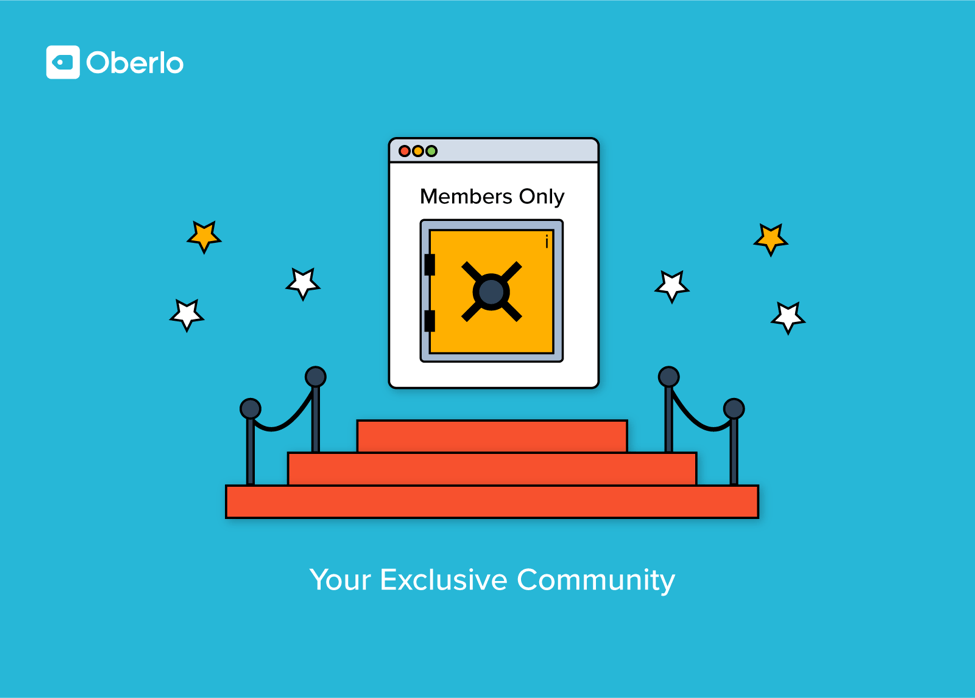
They’ve already shown you they’re interested in what you have to offer.
Now your next task is to create related offers they’re willing to pay for as well.
2.4 Blog monetization tools you should know about
So far, we’ve covered how to earn money from blogging, how to position yourself as an authority, and creating compelling lead magnets that convert your visitors into loyal fans.
Now let’s go over the tools we have at our disposal to monetize your blog idea, specifically three platform examples that hinge on your monetization strategy (WordPress, Teachable, and Shopify), a design tool, and an email automation tool.
WordPress: A flexible blogging platform
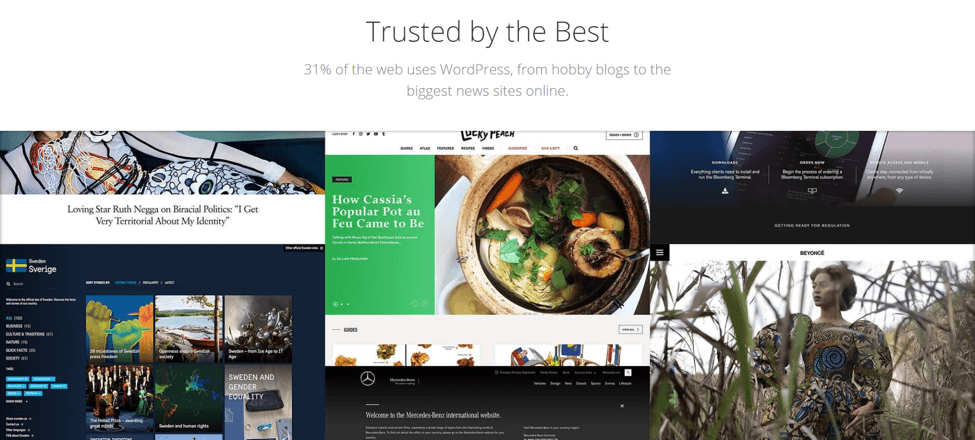
Every blog needs a platform to run on.
The most popular blogging platform, WordPress powers more than 30% of the Internet.
WordPress is definitely the most flexible platform, and if you have any developer experience, this one’s an obvious choice to look into.
The platform also offers numerous themes and plugins. Even the free ones can get the job done for most people starting out trying to earn money from blogging.
And if you’re interested in selling a course but you’re on a budget, you can always purchase a plugin like Learndash for a one-time fee.
[highlight]Curious about WordPress plugins? Check out this awesome list of 15+ awesome wordpress plugins by Themegrill.[/highlight]
Teachable: A platform for course providers
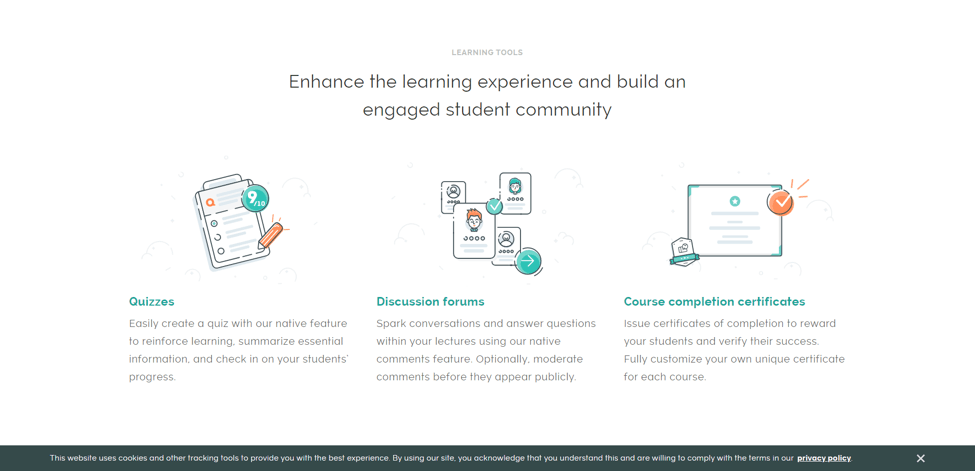
A platform for selling online courses, Teachable is an excellent out-of-the-box solution if you’re not shy about investing up to $299/month.
But don’t worry. You can get started for free.
If you’re not familiar with coding and you’re confident you can make your money back by selling courses with your expertise, then Teachable is worth looking into.
Also worth checking out is Thinkific, Teachable’s direct rival.
Although visually less compelling, it does provide an easier-to-use intuitive course builder compared to Teachable.
Shopify: An ecommerce platform designed for entrepreneurs
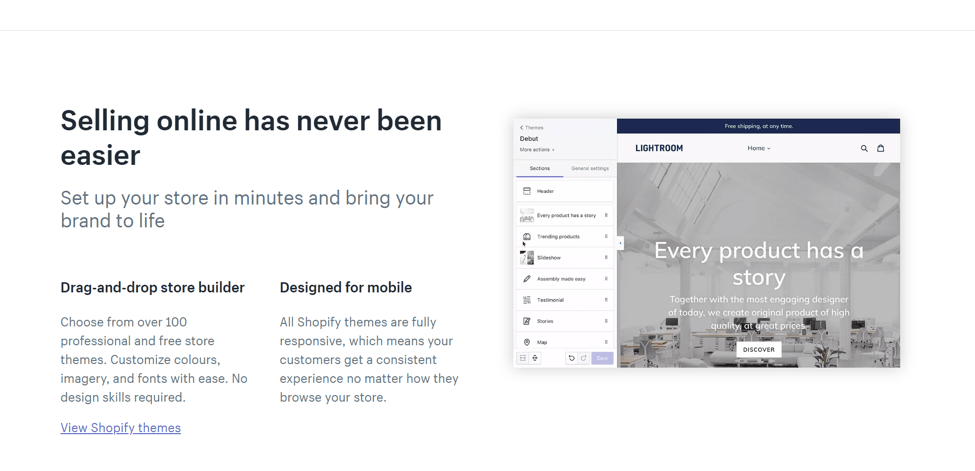
Shopify is the platform for selling products.
It also offers flexible payment options.
For example, you could start out with a Facebook store for as little as $9/month, and scale from there.
Or you could opt for a store with your own website for only $39/month.
Shopify is also highly customizable, and offers themes and plugins, both free and paid, just like WordPress.
Oberlo: The most convenient option for dropshipping
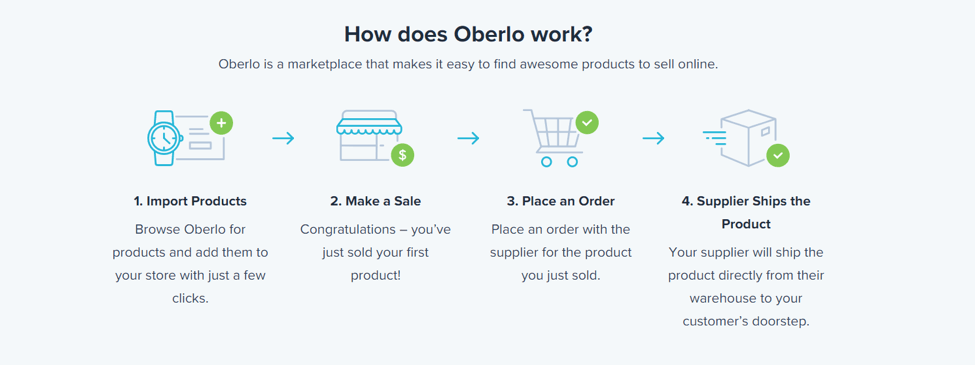
If you’re not sure what to sell, things can get tricky. Purchasing inventory no one ends up buying will cost you not only your money, but your time. And there’s nothing more demotivating than staring at a pile of boxes filled with unsold goods.
But what if there’s a way to hold zero inventory and be able to test out goods in no time?
Enter Oberlo, the most popular dropshipping marketplace on the web, which is designed to keep costs down and save you time.
But what exactly is dropshipping?
In a traditional ecommerce business model, you purchase inventory, store them in a warehouse, and send them to your customers when they purchase.
With dropshipping, it sort of works the other way around. When a customer purchases something on your website (for which you hold no inventory), you contact your supplier and ask them to ship one to your customer directly.
See? No hassle with inventory or distribution channels.
That doesn’t mean dropshipping isn’t without its drawbacks. (Nothing is perfect). The main issue with this model is finding reliable suppliers who will ship quality products to your customers in a timely fashion.
But this is one drawback where Oberlo users have an advantage over other ecommerce entrepreneurs:
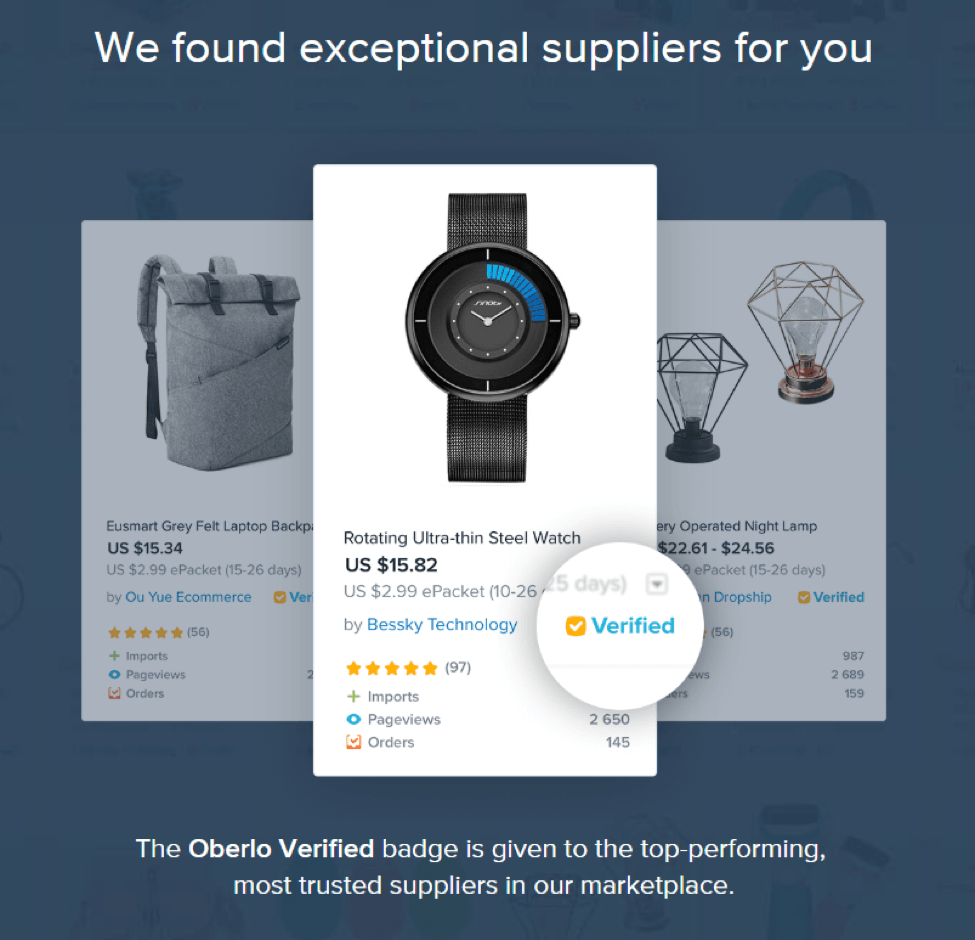
You can shop with confidence in the Oberlo marketplace because its design allows other sellers to rate and review each seller. On top of that, as the image above shows, Oberlo ensures that top sellers have a “Verified” badge next to their store name, so you can rest assured you’re connecting your customers with only the best-performing sellers.
It also comes with a Search function, so you can easily browse all the products offered by Oberlo sellers in seconds. (What convenience!)
By the way, Oberlo integrates directly with your Shopify store, so you can start testing products literally in under an hour. How awesome is that?
If you’re interested in this model, check out this article on how dropshipping with Oberlo works.
[highlight]Want to know which products to sell in 2018? We’ve got you covered. Here’s a video tutorial on how to choose the right products.[/highlight]
Canva: A powerful design tool
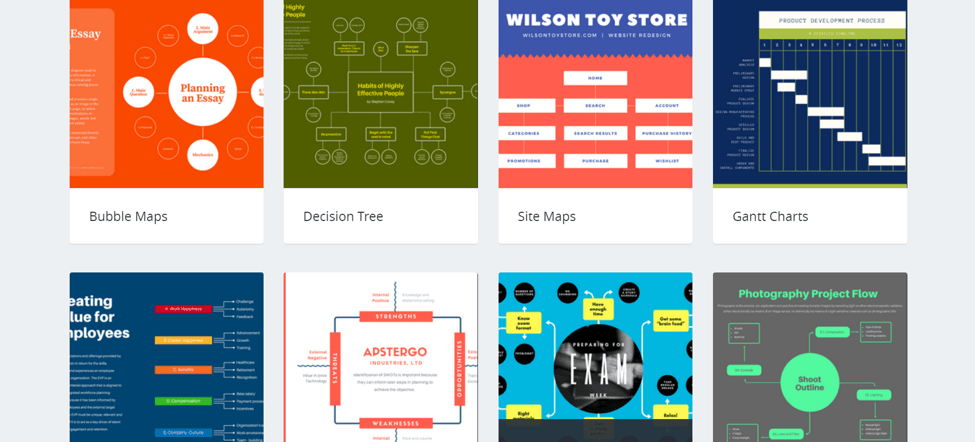
A graphic design tool built to save you time, Canva is a godsend if you have limited design abilities.
There are loads of templates to choose from, depending on your purpose.
The free version will do, but resizing your images can get frustrating from time to time. (This is by far the biggest advantage of the paid version).
If you want to save time designing your lead magnets, be sure to check out Canva.



Chapter 2 Takeaways
We covered a lot in this chapter.
With just the first two chapters alone, you should have a solid understanding of how to earn money from blogging.
Here’s what we went over in this chapter:
- Establishing yourself as an authority and fostering trust with your audience
- Blog ideas that make money
- Email lists, lead magnets, funnels, user intent, and how they all tie in together
- Finding your voice, how to tell a compelling story, and maintaining a consistent style
- And the most essential blogging tools you need for your blog monetization efforts.
In the next chapter, we’ll cover Facebook monetization. We’ll also go over how to leverage Facebook as a blogger and promote your content through Facebook, so be sure to stick around.

